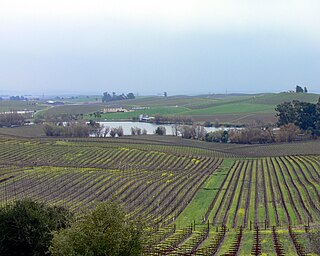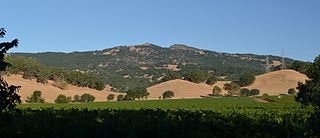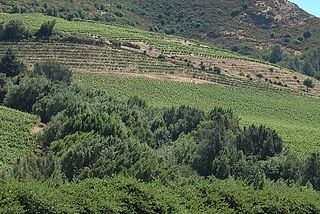
The Alexander Valley is a Californian American Viticultural Area (AVA) just north of Healdsburg in Sonoma County. It is home to many wineries and vineyards, as well as the city of Cloverdale. It is the largest and most fully planted wine region in Sonoma. Highway 101 runs through the valley, and the Russian River flows down the valley, surrounded by vineyards on both sides. From the higher elevations of the valley rim, there is a view as far south as Taylor Mountain and Sonoma Mountain. The region was named for Cyrus Alexander, owner of a part of the Rancho Sotoyome Mexican land grant, in 1847. Granted AVA status in 1984, the boundaries of the appellation are defined in the Code of Federal Regulations, Title 27, Section 9.53.

Washington wine is a wine produced from grape varieties grown in the U.S. state of Washington. Washington ranks second in the United States in the production of wine. By 2017, the state had over 55,000 acres (220 km2) of vineyards, a harvest of 229,000 short tons (208,000 t) of grapes, and exports going to over 40 countries around the world from the 940+ wineries located in the state. While there are some viticultural activities in the cooler, wetter western half of the state, the majority (99.9%) of wine grape production takes place in the shrub-steppe eastern half. The rain shadow of the Cascade Range leaves the Columbia River Basin with around 8 inches (200 mm) of annual rain fall, making irrigation and water rights of paramount interest to the Washington wine industry. Viticulture in the state is also influenced by long sunlight hours and consistent temperatures.

Napa Valley is an American Viticultural Area (AVA) located in Napa County, California. It was established by the Bureau of Alcohol, Tobacco and Firearms (ATF) on January 27, 1981. Napa Valley is considered one of the premier wine regions in the world. Records of commercial wine production in the region date back to the nineteenth century, but premium wine production dates back only to the 1960s.
Knights Valley AVA is an American Viticultural Area (AVA) in Sonoma County, California. One of Sonoma County's original five AVAs, Knights Valley AVA was formally designated an American Viticultural Area on October 21, 1983. Knights Valley AVA includes approximately 37,000 acres (150 km2). Over 30 growers maintain the 2,000 acres (8 km2) planted to wine grape vineyards. The easternmost designated Sonoma County wine region, Knights Valley AVA has the warmest climate in the county. The valley lies between the Alexander Valley AVA and Chalk Hill AVA wine regions to the west and the Mayacamas Mountains to the east. Geographically, the appellation separates the rest of Sonoma County from the Napa Valley AVA.

The Mendocino County wine is an appellation that designates wine made from grapes grown mostly in Mendocino County, California. The region is part of the larger North Coast AVA and one of California's largest and most climatically diverse wine growing regions. Mendocino County is one of the northernmost commercial wine grape regions in the state with two distinct climate zones separated by the Mendocino Range. Ten American Viticultural Areas have been designated within Mendocino County. Mendocino is one of the leading wine growing regions for organically produced wine grapes. Nearly 25% of the acreage in Mendocino County is grown organically. In 2004, the residents of the county voted to become the first GMO-free county in the United States in an initiative that was supported by many of the county's largest wineries. The county's widespread focus on organic viticulture has inspired journalists to describe it as "California's organic wine Mecca".

Sonoma County wine is wine made in Sonoma County, California, in the United States.

Los Carneros AVA is an American Viticultural Area which includes parts of both Sonoma and Napa counties in California, U.S.A. It is located north of San Pablo Bay. The proximity to the cool fog and breezes from the bay makes the climate in Los Carneros cooler and more moderate than the wine regions farther north in Napa Valley and Sonoma Valley. The cooler climate has made Los Carneros attractive for the cultivation of cooler climate varietals like Pinot noir and Chardonnay. Many of the grapes grown in Los Carneros are used for sparkling wine production. Receiving its AVA status in 1983, the Carneros area was the first wine region in California to be defined by its climate characteristics rather than political boundaries.
The Green Valley of Russian River Valley AVA is an American Viticultural Area in Sonoma County, California, United States. Located at the southwestern corner of the Russian River Valley AVA, its close proximity to the Pacific Ocean makes it one of the coolest appellations within Sonoma County. The climate in the Green Valley is even cooler than other parts of the Russian River Valley, and favors the cultivation of cool climate varietals like Pinot noir, Chardonnay and Gewürztraminer.
The Northern Sonoma AVA is an American Viticultural Area in Sonoma County, California, United States. The appellation covers most of the county with the notable exceptions of the Los Carneros AVA and Sonoma Valley AVA wine regions, which are located in the southern portion of the county. The creation of this AVA was largely based on the petitioning of the E & J Gallo Winery as part of their expansion of their Gallo of Sonoma brand. The viticultural area incorporates the Alexander Valley AVA, Chalk Hill AVA, Dry Creek Valley AVA, Knights Valley AVA, Russian River Valley AVA, Sonoma Coast AVA, and parts of the Green Valley of Russian River Valley AVA and Rockpile AVA valleys.

The Russian River Valley AVA is an American Viticultural Area (AVA) in Sonoma County, California. Centered on the Russian River, the Russian River Valley AVA accounts for about one-sixth of the total planted vineyard acreage in Sonoma County. The appellation was granted AVA status in 1983 and enlarged in 2005. The area generally lies between Sebastopol and Santa Rosa in the south, and Forestville and Healdsburg in the north. The Russian River Valley has a characteristically cool climate, heavily affected by fog generated by the valley's proximity to the Pacific Ocean. The area is known for its success with cool climate varietals, notably Pinot noir and Chardonnay.

The Sonoma Valley AVA is an American Viticultural Area in Sonoma County, California which centers on the Sonoma Valley in the southern portion of the county. The name 'Sonoma' means 'Valley of the Moon' in the local Native American dialect. The appellation is bordered by two mountain ranges: the Mayacamas Mountains to the east and the Sonoma Mountains to the west.
Mount Veeder AVA is an American Viticultural Area located within Napa Valley AVA among the Mayacamas Mountains. The boundaries of this appellation include 25 sq mi (64.7 km2) with 1,000 acres (400 ha) planted on thin volcanic soil. Many vineyards are found on the steep mountain face some as steep as 30°. The steepness of the angle gives the vineyards benefits of more direct sunlight and better drainage.

The Diamond Mountain District AVA is an American Viticultural Area located in California's Mayacamas Mountains in the northwest portion of the Napa Valley AVA. The appellation sits at a higher elevation than most of Napa Valley's wine region, resulting in less cool fog coming in from San Pablo Bay, and more direct exposure to sunlight. The soil of this AVA is volcanic and very porous which allows it to cool down quickly despite the increased sunlight.

The Howell Mountain AVA is an American Viticultural Area located within Napa Valley AVA of California.

The Spring Mountain District AVA is an American Viticultural Area located in the Napa Valley AVA in California. Spring Mountain District AVA was officially established as an American Viticulture Area in 1993. Encompassed within its bounds are about 8,600 acres (3,480 ha), of which about 1,000 acres (400 ha) are planted to vineyards. Given the small crop yields on hillsides, the region represents less than 2% of Napa Valley wine. Currently the region has just over 30 winegrowers.

El Dorado is an American Viticultural Area (AVA) located in El Dorado County, California, east of the state’s capital, Sacramento and centered around the county seat of Placerville. It was established on November 14, 1983 by the Bureau of Alcohol, Tobacco, Firearms and Explosives (ATF), Treasury after approving the submitted petition from the El Dorado Wine Grape Growers Association of Camino, California applying to establish a viticultural area named "El Dorado.” The area includes parts of El Dorado County on the north border by the Middle Fork American River and on the south by the South Fork of the Cosumnes River. El Dorado viticultural area lies within the vast 4,062 square miles Sierra Foothills viticultural area, one of the largest appellations in California, which extends about 170 miles (274 km) through portions of Yuba, Nevada, Placer, El Dorado, Amador, Calaveras, Tuolumne and Mariposa Counties. The El Dorado viticultural area encompasses 1,093,120 acres (1,708 sq mi) which entirely includes Fair Play and a small portion of northeastern California Shenandoah Valley AVAs.
The Pine Mountain-Cloverdale Peak AVA is an American Viticultural Area in Sonoma County. It is located at the top of Pine Mountain, at the Northern end of the Mayacamas Range, which separates the Napa and Sonoma growing regions. The AVA, which rises between 1600 feet at its lowest point to 2600 feet at its highest, is one of the highest grape growing regions in California.

The Howell Mountains, which are also known as the Mt. George Range, are one of the California Coast Ranges. They divide the Suisun Valley on the east side, from Napa Valley on the west. Historically the southern part of the range has been referred to as both the Sierra de Suscol and as the Sierra de Napa.
Kelsey Bench-Lake County is an American Viticultural Area located in Lake County, California. The area is home to some 900 acres of vines in 27 vineyards, and was officially established as an AVA by the Alcohol and Tobacco Tax and Trade Bureau (TTB) in October 2013. Sauvignon blanc, Chardonnay, Viognier and Riesling are the principal white grape varieties within Kelsey Bench and its neighbor the Big Valley District AVA. Zinfandel, Merlot and Cabernet Franc varieties make up the majority of red grape plantings in the area.

Moon Mountain District Sonoma County is an American Viticultural Area (AVA) within Sonoma Valley and North Coast viticultural areas, just north of the city of Sonoma. This mountainous region on the very eastern edge of Sonoma County has a historic reputation for producing rich, intensely-flavored wines from Cabernet Sauvignon and Syrah varietals since the 1880s. The District was established on November 1, 2013, by the Alcohol and Tobacco Tax and Trade Bureau (TTB). Its designation covers 17,663 acres (28 sq mi) of land stretching north-south along the western slopes of the Mayacamas mountains between Sugarloaf Ridge State Park and Los Carneros viticultural area with the Napa Valley’s Mount Veeder viticultural area outlining the eastern slopes. Its name is derived from Moon Mountain Road, which traverses through the area and itself a reference to Sonoma, which means 'valley of the moon' in the local Native American dialect. A clear view to San Francisco 50 miles (80 km) south is not uncommon from Moon Mountain District vineyards.














